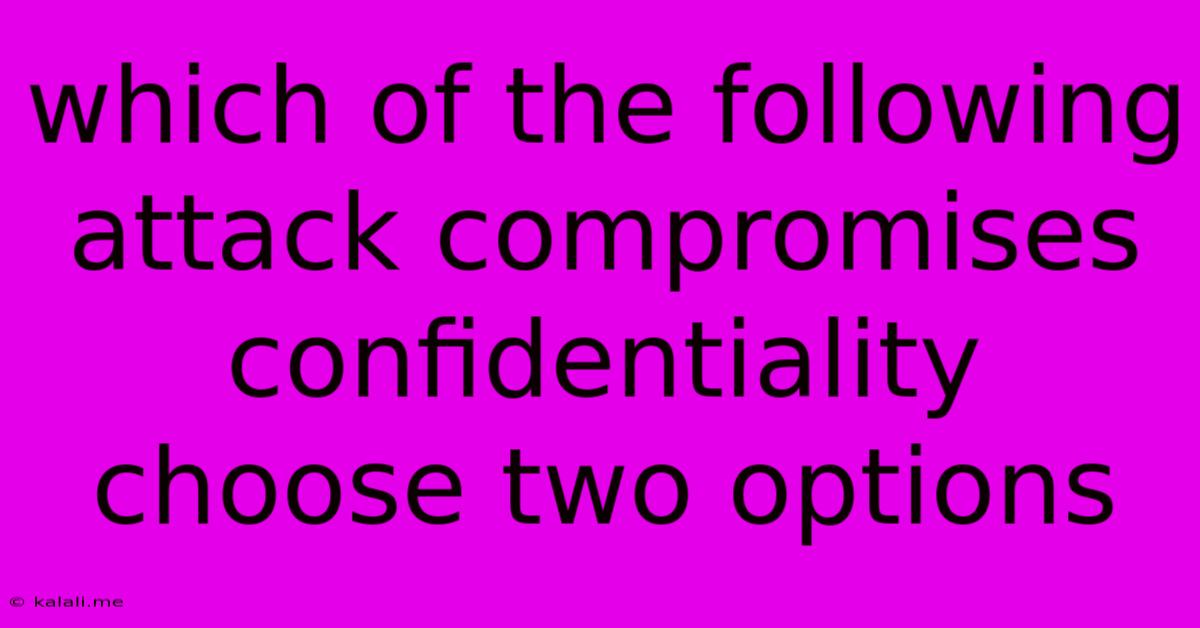Which Of The Following Attack Compromises Confidentiality Choose Two Options
Kalali
Jun 16, 2025 · 3 min read

Table of Contents
Which of the Following Attacks Compromises Confidentiality? (Choose Two Options)
This article explores attacks that compromise confidentiality, a core principle of cybersecurity. Confidentiality ensures that sensitive information is accessible only to authorized individuals or systems. We'll examine several attack types and identify two that directly violate this principle. Understanding these attacks is crucial for implementing effective security measures.
What is Confidentiality?
Confidentiality is the protection of sensitive information from unauthorized access, use, disclosure, disruption, modification, or destruction. It's a fundamental aspect of data security and privacy, ensuring that only authorized parties can view or utilize specific data. Breaches of confidentiality can have severe consequences, from financial losses to reputational damage and legal repercussions.
Attacks that Compromise Confidentiality:
Several attack vectors can directly compromise confidentiality. Let's analyze some common ones:
1. Man-in-the-Middle (MITM) Attack:
A MITM attack allows an attacker to secretly intercept and relay communication between two parties who believe they are directly communicating with each other. The attacker can eavesdrop on the conversation, read sensitive data, and even modify the information exchanged without the knowledge of either party. This directly violates confidentiality because the data is exposed to an unauthorized entity. Think of it like a malicious eavesdropper on a phone call. Encryption protocols are crucial in mitigating this type of attack.
2. Eavesdropping:
This is a straightforward attack where the attacker passively listens to network traffic or intercepts data transmission to capture sensitive information. This could involve physical tapping into cables, using specialized hardware to intercept wireless signals (like Wi-Fi sniffing), or exploiting vulnerabilities in software to gain access to data streams. Eavesdropping is a classic example of a confidentiality breach because unauthorized individuals gain access to private data.
3. Phishing:
While phishing attacks are primarily used for credential theft, they ultimately lead to confidentiality breaches. By tricking users into revealing sensitive information like passwords, credit card details, or personally identifiable information (PII), attackers gain access to data that should remain confidential. Phishing attacks exploit social engineering techniques to manipulate users.
4. Denial-of-Service (DoS) Attack:
A DoS attack aims to make a machine or network resource unavailable to its intended users. While not directly accessing confidential information, a successful DoS attack can indirectly compromise confidentiality by preventing authorized users from accessing sensitive data. For example, a DoS attack on a company's server could prevent employees from accessing confidential client information. This is more of an availability issue than a direct confidentiality breach, though it can have severe secondary effects on confidentiality.
5. SQL Injection:
SQL injection attacks exploit vulnerabilities in poorly written database applications. Attackers inject malicious SQL code into input fields to manipulate database queries and extract sensitive information. This directly compromises confidentiality by giving unauthorized access to data stored in the database. Input validation and parameterized queries are essential countermeasures.
The Answer:
Of the attacks listed, the two that most directly compromise confidentiality are:
- Man-in-the-Middle (MITM) Attack: The attacker directly intercepts and views sensitive data exchanged between two parties.
- Eavesdropping: The attacker passively intercepts and captures sensitive data during transmission.
Understanding these attacks and employing appropriate security measures are essential for protecting sensitive data and maintaining confidentiality. Regular security audits, employee training on security awareness, and robust security protocols are vital in preventing these breaches.
Latest Posts
Latest Posts
-
How To Calculate Atomic Packing Factor
Jun 16, 2025
-
Difference Between Keratinized And Nonkeratinized Epithelium
Jun 16, 2025
-
Whats The Difference Between Hypothesis And Prediction
Jun 16, 2025
-
What Is The Prime Factorization For 124
Jun 16, 2025
-
Difference Between Economies Of Scope And Economies Of Scale
Jun 16, 2025
Related Post
Thank you for visiting our website which covers about Which Of The Following Attack Compromises Confidentiality Choose Two Options . We hope the information provided has been useful to you. Feel free to contact us if you have any questions or need further assistance. See you next time and don't miss to bookmark.